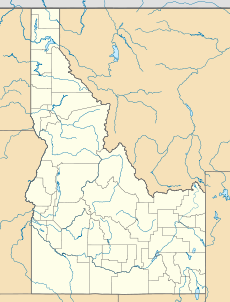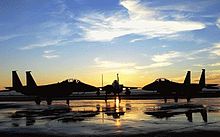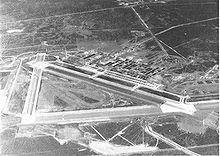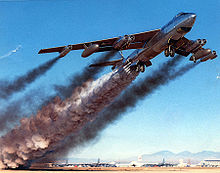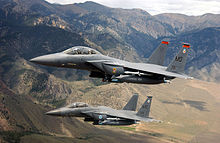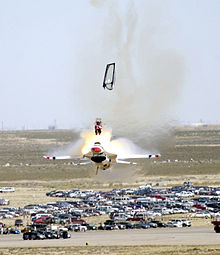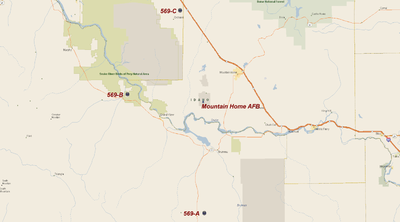- Mountain Home Air Force Base
-
Mountain Home Air Force Base Part of Air Combat Command (ACC) Located near: Mountain Home, Idaho 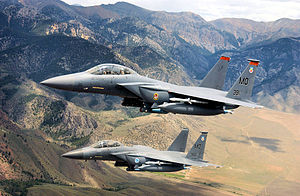
F-15Es of the 366th Operations GroupCoordinates 43°02′37″N 115°52′21″W / 43.04361°N 115.8725°W Built 1942 In use 1942-Present Controlled by  United States Air Force
United States Air ForceGarrison 
366th Fighter WingAirfield information IATA: MUO – ICAO: KMUO – FAA LID: MUO Summary Elevation AMSL 2,996 ft / 913 m Website Runways Direction Length Surface ft m 12/30 13,500 4,115 PEM Mountain Home Air Force Base (IATA: MUO, ICAO: KMUO, FAA LID: MUO) is a United States Air Force installation located in southwestern Idaho, United States. The base is in Elmore County, 12 miles (20 km) southwest of the city of Mountain Home, which is 40 miles (65 km) southeast of Boise, via Interstate 84.
The host unit at Mountain Home since 1972 has been the 366th Fighter Wing (366 FW) of the Air Combat Command (ACC), nicknamed the "Gunfighters." The base's primary mission is to provide combat airpower and combat support capabilities to respond to and sustain worldwide contingency operations.
Part of the base is a census-designated place (CDP); the population was 3,238 at the 2010 census.[1]
Contents
- 1 Units
- 2 History
- 3 Geography
- 4 Demographics
- 5 See also
- 6 References
- 7 Further reading
- 8 External links
Units
Mountain Home AFB is the home of the 366th Fighter Wing (366 FW), which reports to Air Combat Command (ACC). The mission of the 366 FW is to prepare Airmen and their families, professionally and personally, for expeditionary operations and foster an environment that promotes integration of all facets of wing operations.
The wing comprises four groups and three operational fighter squadrons:
- 366th Operations Group (Tail code: "MO")
- 389th Fighter Squadron (F-15E Strike Eagle)
- 391st Fighter Squadron (F-15E Strike Eagle)
- 428th Fighter Squadron (F-15SG)
- 366th Maintenance Group
- 366th Mission Support Group
- 366th Medical Group
In addition, the 726th Air Control Squadron gives an air picture to the aircraft as they train. An active Idaho Air National Guard unit, the 266th Range Squadron, controls and maintains emitter sites within the 7,412-square-mile (19,200 km2) operational training range located in southern Idaho.
History
Construction of the field began in October 1942, and it officially opened August 7, 1943.
World War II
Crews started building the base in November 1942 and the new field officially opened on August 7, 1943. Shortly thereafter, airmen at the field began training United States Army Air Force crews for World War II. The 396th Bombardment Group (Heavy) was the first unit assigned and its planned mission was to train crews for the B-17 Flying Fortress. However, before the first B-17s arrived, plans for the field changed and the 396th was transferred to Moses Lake AAF, Washington.
Instead of training B-17 crews, Mountain Home airmen began training crews for the B-24 Liberator. The first group to do so was the 470th Bombardment Group (Heavy), which trained at Mountain Home from May 1943 until January 1944, when the unit moved to Tonopah AAF Nevada. The 490th Bombardment Group (Heavy) replaced the 470th and trained B-24 crews until it deployed to RAF Eye England in April 1944. The 494th Bombardment Group then replaced the 490th, once more training Liberator crews.
The base also received fighter aircraft to add realism to its training. A few P-38 Lightning and P-63 Kingcobra pursuit planes arrived in January 1945 to simulate attacks on B-24s. In June 1945, Mountain Home also briefly served as a training base for the new B-29 Superfortress with the 301st Bombardment Group (Very Heavy) training for combat, but the Japanese surrender in August brought a swift end to the new mission and, for a time, to the base at Mountain Home.
The base was placed in inactive status in October 1945.
Postwar era
The base remained inactive until December 1948 when the newly independent United States Air Force reopened the base. A provisional unit, the 4205th Air Base Group, was activated on 12 December to prepare the newly re-designated Mountain Home Air Force Base for operational use
5th Strategic Reconnaissance Wing
Mountain Home's first operational USAF unit was the Strategic Air Command (SAC) 5th Strategic Reconnaissance Group which was reassigned from Clark Field in the Philippines, being assigned on 26 May 1949. The mission of the 5th Strategic Reconnaissance Group (later 5th Strategic Reconnaissance Wing) was long-range strategic reconnaissance, primarily of the periphery of the Soviet Union. It's primary operational squadron was the 72d Reconnaissance Squadron, which had been had been assigned to the group from Ladd AFB, Alaska Territory where it had operated RB-29 Superfortress for several years. On 3 September 1949, aircraft of the 72d identified the first evidence of a successful explosion of a Soviet nuclear weapon in the Semipalatinsk test site in Eastern Kazakhstan on 29 August 1949
The pending assignment of the new RB-36 Peacemaker to the 5th SRW, along with the inadequacy of its World War II facilities to support the large aircraft led SAC to move the 5th SRW to Fairfield-Suisun AFB, California on 9 November 1949. The provisional 4209th Base Service Squadron was assigned to the base which supervised construction activities to modernize facilities and also construct a 12,000-foot runway. The base was formally closed on 25 April 1950, however the 5th SRW maintained control of Mountain Home from Fairfield-Suisn AFB, maintaining it as a subbase.
Military Air Transport Service
In early 1951, enough construction was completed that jurisdiction of Mountain Home was transferred to Military Air Transport Service (MATS), which assigned it to the Air Resupply And Communications Service (ARCS). ARCS was Special Operations organization, which performed Psychological Warfare missions. Mountain Home AFB was selected as a training base for ARCS, for which it was well-suited due to the relative remoteness of the facility.
ARCS formed the 580th, 581st, and 582nd Air Resupply and Communications Wings at the base, equipping with wings with C-119 Flying Boxcar, B-29 Superfortress, and SA-16 Albatross aircraft and trained to support covert special operations. Once manned, equipped and trained, the groups deployed to various parts of the world, performing classified missions during the early part of the Cold War.
9th Bombardment Wing
In early May 1953, the major construction on the base was completed, and SAC was able to use its long runway for strategic bomber operations. Jurisdiction of Mountain Home AFB was transferred back to SAC on 1 May 1953.
SAC moved its 9th Bombardment Wing to the base and began flying B-29 bombers and KB-29H refueling aircraft. The 9th converted to the new B-47 Stratojet bomber and the KC-97 Stratotanker air refueling aircraft in September 1954, and kept alert bombers ready for war at a moment's notice and continued its mission as a SAC deterrent force through the early Cold War years of the 1950s and early 1960s.
In 1959, construction of three HGM-25A Titan I missile sites began in the local area. The 569th Strategic Missile Squadron controlled these sites and was assigned to the 9th Bombardment Wing in August 1962. To prepare for the addition of missiles to its bomber forces, the USAF re-designated the wing as the 9th Strategic Aerospace Wing in April 1962.
Two years later, SAC's mission at MHAFB began to wind down as part of the phaseout of the B-47. In November 1964, the Air Force announced that the Titan I was also being phased out. In late 1965 SAC phased down operations at Mountain Home, and jurisdiction was transferred to Tactical Air Command for use.
67th Tactical Reconnaissance Wing
In November 1965 TAC began to activate elements of its new 67th Tactical Reconnaissance Wing (67th TRW) at Mountain Home, formally activating the wing on 1 January 1966. The mission of the 67th TRW was to conduct photographic, visual, radar, and thermal reconnaissance operations. While having these operational commitments, it also conducted replacement training for RF-4C Phantom II crew members being deployed to Southeast Asia.
In September 1966, the wing's 12th Tactical Reconnaissance Squadron transferred to the 460th Tactical Reconnaissance Wing at Tan Son Nhut Air Base, South Vietnam. As required, the 67 TRW also supported operations when crew members ferried RF-4Cs to the war theater.
Beginning in 1968, the 67th also conducted tactical fighter operations with the addition of a squadron of F-4D Phantom IIs. This fighter mission lasted until late 1970 when the F-4Ds were reassigned. When U.S. forces began the drawdown from South Vietnam, the 67th TRW designation moved in July 1971 to Bergstrom AFB, Texas.
347th Tactical Fighter Wing
With the move of the RF-4Cs to Bergstrom, TAC activated its 347th Tactical Fighter Wing at Mountain Home, which has been phased down by PACAF at Yokota AB, Japan in May 1971. With the activation of the 347th, TAC chose it to be the first wing equipped with the new General Dynamics F-111F, an advanced version of the F-111A which had been unsuccessfully tested in the Vietnam War in Operation Combat Lancer March 15 to April 22, 1968. It differed from the F-111A in having more advanced electronics, more powerful engines, and major structural improvements.
The first F-111F entered service with the 374th TFW in January 1972. The entire wing became operationally ready in October 1972. The 347th had a short stay at Mountain Home, conducting F-111F training until October, when the 366 TFW moved from Vietnam to Mountain Home. Upon its arrival, the 366th absorbed all the personnel and equipment of the 347th, which was inactivated.
366th Fighter Wing
The 366th Fighter Wing (in various designations) has been the host unit at Mountain Home for over 35 years, following its return from the Vietnam War in late 1972.
Before the 366th Tactical Fighter Wing's arrival at Mountain Home, the 389th, 390th, and 391st Tactical Fighter Squadrons had returned from South Vietnam, joined the 347th, and began converting to F-111F aircraft. For the first time since it left for Vietnam, the wing once again had its three original flying units.
Operations continued unchanged for several years. The wing tested its readiness in August 1976 when a border incident in Korea prompted the United States to augment its military contingent in South Korea as a show of force. The 366th deployed a squadron of 20 F-111 fighters, which reached Korea only 31 hours after receiving launch notification. Tensions eased shortly afterward and the detachment returned home.
In early 1991, the Air Force announced that the 366th would become the Air Force's premier "air intervention" composite wing. The wing would grow with the addition of a squadron of EF-111A Raven electronic warfare aircraft and a squadron of B-1B Lancer bombers to become a dynamic, five squadron wing with the ability to deploy rapidly and deliver integrated combat airpower.
The air intervention composite wing's rapid transition from concept to reality began in October 1991 when Air Force redesignated the wing as the 366th Wing. The wing's newly reactivated "fighter squadrons" became part of the composite wing in March 1992. The 389th Fighter Squadron began flying the dual-role F-16C Fighting Falcon, while the 391st Fighter Squadron was equipped with the new F-15E Strike Eagle. These two squadrons provide Gunfighters round-the-clock precision strike capability.
Following the terrorist attacks on September 11, 2001, the resultant initiation of Operation ENDURING FREEDOM (OEF), the 366th Wing once again got the call. While the 34th Bomb Squadron deployed to Diego Garcia as the B-1 component of the 28th Air Expeditionary Wing, the wing sent a Base Operations Support package to Al Udeid Air Base, Qatar, to transform the bare base into a fully functional airfield for large-scale combat operations. In October 2001, the 391st Fighter Squadron deployed to Al Jaber Air Base, Kuwait, while the 389th Fighter Squadron went to Al Udeid in November.
Following the wing's return from Southwest Asia, the Air Force began consolidating its B-1 Lancer and KC-135 Stratotanker forces. This led to the reallocation of the wing's bombers and tankers. The 22 ARS' aircraft began transferring to McConnell AFB, Kansas, in May 2002 and the squadron inactivated the following August. The 34 BS' B-1Bs began moving to Ellsworth AFB, South Dakota, in June and the squadron officially moved in September. Following the departure of these assets, the Air Force re-designated the 366th as a Fighter Wing. With these changes, the wing's 10-year mission as the Air Force's only standing air expeditionary wing came to an end. A continued reconstruction of the 366 Fighter Wing was official with the 2005 base realignment, coinciding with the large scale integration of the 150+ F-22 Raptors. After the F-16 departure, Mountain Home Air Force Base was chosen to become an F-15E installation because of its ideal training terrain range that is suited for air-to-ground, and air-to-air training missions.
Over the horizon radar
About 1985, Air Force Materiel Commandactivated the 776th Radar Squadron at Bangor ANGB. The mission of the squadron was to operate two Over the horizon radar (OTH-B) very long-range early warning radar sites. The squadron operated a OTH-B Transmitter site at Christmas Valley AFS, Oregon, 43°16′45″N 120°22′45″W / 43.27917°N 120.37917°W and a receiver site at Tule Lake AFS, California 41°42′00″N 121°10′40″W / 41.7°N 121.17778°W. These systems were inactivated in 1997, and the unit was inactivated.
Thunderbirds crash
The base was the site of a Thunderbirds crash on September 14, 2003, which fortunately resulted in no fatalities.[2] Immediately after takeoff, Captain Chris Stricklin, flying Thunderbird 6, serial #87-0327 (opposing solo), attempted a "Split S" maneuver (which he had successfully performed over 200 times) based on an incorrect mean-sea-level elevation. Similar in desert appearance, MHAFB is 1100 feet (335 m) higher than the Thunderbirds' home at Nellis AFB near Las Vegas, Nevada.
Climbing to only 1670 feet (509 m) above ground level instead of 2500 feet (762 m), Stricklin had insufficient altitude to complete the descending half-loop maneuver. He guided the F-16C aircraft down runway 30, away from the spectators and ejected less than one second before impact. His parachute deployed when he was just above the ground and Stricklin survived with only minor injuries. No one on the ground was injured, but the $20 million aircraft was completely destroyed.[3]
- video of crash of Thunderbird 6 - 2003-09-14
Official procedure for demonstration "Split-S" maneuvers was changed, and the USAF now requires Thunderbird pilots and airshow ground controllers to both work in above-MSL (mean-sea-level) altitudes, as opposed to ground control working in AGL (above-ground-level) and pilots in MSL, which led to two sets of numbers that had to be reconciled by the pilot. Thunderbird pilots now also climb an extra 1000 feet (305 m) before performing the Split S maneuver.[3] [4]
Previous names
- Army Air Base, Mountain Home, Nov 1942
- Mountain Home Army Air Field, 2 Dec 1943.
- Mountain Home Air Force Base, 13 Jan 1948–Present
Major commands to which assigned
- Second Air Force, 29 August 1942
- Fourth Air Force, 15 February 1945
- Continental Air Forces, 16 April 1945
- Temporary inactive status, 5 Oct 1945.
- Subbase of Gowen Army Airfield, Idaho, 9 Oct 1945
- Subbase of Walla Walla Army Airfield, Washington, 31 Dec 1945-30 September 1946
- Strategic Air Command, 21 March 1946
- Activated on 1 December 1948
- Inactivated on 25 April 1950
- Subbase of Fairfield-Suisun (later, Travis) AFB, California, c. 1 Apr 1950-24 Jan 1951
- Military Air Transport Service, 24 January 1951
- Activated on 1 Feb 1951
- Strategic Air Command, 1 May 1953
- Tactical Air Command, 1 January 1966
- Air Combat Command, 1 June 1992 – Present
Major units assigned
- 396th Bombardment Group (Heavy), 16 February–10 April 1943
- 470th Bombardment Group (Heavy), 1 May 1943–1 January 1944
- 467th Bombardment Group (Heavy), 8 September–17 October 1943
- 490th Bombardment Group, Heavy, 4 December 1943–20 April 1944
- 494th Bombardment Group (Heavy), 15 April–1 June 1944
- 4205th Air Base Group, 12 December 1948-16 July 1949
- 5th Reconnaissance Group, Very Long Range, Photo, 29 May-16 July 1949
- 5th Strategic Reconnaissance Wing, 16 July–11 November 1949
- 1300th Air Base Wing, 1 November 1951-30 April 1953
- 580th Air Resupply and Communications Wing, April 16, 1951 – September 17, 1952
- 581st Air Resupply and Communications Wing, July 23, 1951 – June 26, 1952
- 582nd Air Resupply and Communications Wing, September 24, 1952 – May 1, 1953
- 9th Bombardment Wing, Medium (later 9th Strategic Aerospace Wing), May 1, 1953 – June 25, 1966
- 813th Air Division, July 1, 1959 – July 1, 1964
- 569th Strategic Missile Squadron, June 1961-March 1965
- 67th Tactical Reconnaissance Wing, January 1, 1966 – July 15, 1971
- 347th Tactical Fighter Wing, May 15, 1971 – October 31, 1972
- 366th Tactical Fighter Wing, October 31, 1972 – October 1, 1991
- Redesignated 366th Wing, October 1, 1991 – September 27, 2002
- Redesignated 366th Fighter Wing, September 27, 2002 – present
Intercontinental ballistic missile facilities
The 569th Strategic Missile Squadron Operated three HGM-25A Titan I ICBM sites: (1 Jun 1961-25 Jun 1965)
- 569-A, 12 miles SW of Hot Spring, Idaho 42°40′14″N 115°52′02″W / 42.67056°N 115.86722°W
- 569-B, 7 miles E of Oreana, Idaho 43°03′58″N 116°15′50″W / 43.06611°N 116.26389°W
- 569-C, 3 miles NE of Orchard, Idaho 43°20′42″N 115°59′33″W / 43.345°N 115.9925°W
The activation of the 569th SMS marked the last such activation of a Titan I squadron within Strategic Air Command. The 569th would join with two Titan I squadrons at Lowry AFB, to be the last Titan I squadrons to undergo inactivation in June 1965.
Today, all three of the squadron's launch sites are in remote areas and temperatures in the areas tend to be extreme, ranging from over 100 degrees Fahrenheit during the summer to -20 F in the winter. 569-A is largely obliterated, with none of the three silos appearing to remain. Site "B" is also largely obliterated and has been turned into a toxic waste dump site. Site "C" appears to be largely intact. Whomever owns it has erected several buildings on the site, with part of it being used as an auto graveyard.
Geography
Mountain Home AFB is located at (43.049511, -115.866452),[5]
at an elevation of 2996 feet (913 m) above sea level.According to the United States Census Bureau, the CDP has a total area of 9.9 square miles (25.7 km²), and 0.10% is water.
Demographics
Historical populations Census Pop. %± 1970 6,038 — 1980 6,403 6.0% 1990 5,936 −7.3% 2000 8,894 49.8% 2010 3,238 −63.6% source:[6][7] As of the census[8] of 2000, there were 8,894 people, 1,476 households, and 1,452 families residing in the CDP. The population density was 896 per suare mile (346/km²). There were 1,590 housing units at an average density of 160 per square mile (62/km²). The racial makeup of the CDP was 83.2% White, 6.9% Black or African American, 0.8% Native American, 2.5% Asian, 0.2% Pacific Islander, 2.7% from other races, and 3.7% from two or more races. Hispanic or Latino of any race were 6.5% of the population.
There were 1,476 households out of which 76.4% had children under the age of 18 living with them, 91.9% were married couples living together, 4.4% had a female householder with no husband present, and 1.6% were non-families. 1.4% of all households were made up of individuals and none had someone living alone who was 65 years of age or older. The average household size was 3.40 and the average family size was 3.43.
In the CDP the population was spread out with 24.0% under the age of 18, 24.4% from 18 to 24, 49.7% from 25 to 44, 1.8% from 45 to 64, and 0.1% who were 65 years of age or older. The median age was 25 years. For every 100 females there were 180.8 males. For every 100 females age 18 and over, there were 219.5 males.
The median income for a household in the CDP was $31,634, and the median income for a family was $31,377. Males had a median income of $24,865 versus $20,664 for females. The per capita income for the CDP was $17,671. About 6.5% of families and 7.4% of the population were below the poverty line, including 9.1% of those under age 18 and none of those age 65 or over.
See also
- Idaho World War II Army Airfields
- Fighter Wing: A Guided Tour of an Air Force Combat Wing - by Tom Clancy
References
- ^ "American FactFinder". U.S. Census Bureau. http://factfinder2.census.gov/main.html. Retrieved 22 March 2011.
- ^ "Thunderbird accident report released". F-16.net, 22 January 2004.
- ^ a b [1] "Crash report". Retrieved: 04 September 2010.
- ^ "Thunderbird accident report released". F-16.net. http://www.f-16.net/news_article968.html. Retrieved 24 July 2010. This article includes a link to the cockpit video of the ejection.
- ^ "US Gazetteer files: 2010, 2000, and 1990". United States Census Bureau. 2011-02-12. http://www.census.gov/geo/www/gazetteer/gazette.html. Retrieved 2011-04-23.
- ^ Moffatt, Riley. Population History of Western U.S. Cities & Towns, 1850-1990. Lanham: Scarecrow, 1996, 96.
- ^ "Subcounty population estimates: Idaho 2000-2007" (CSV). United States Census Bureau, Population Division. 2009-03-18. http://www.census.gov/popest/cities/files/SUB-EST2007-16.csv. Retrieved 2009-06-17.
- ^ "American FactFinder". United States Census Bureau. http://factfinder.census.gov. Retrieved 2008-01-31.
Further reading
 This article incorporates public domain material from websites or documents of the Air Force Historical Research Agency.
This article incorporates public domain material from websites or documents of the Air Force Historical Research Agency.
 This article incorporates public domain material from the United States Government document "Mountain Home Air Force Base".
This article incorporates public domain material from the United States Government document "Mountain Home Air Force Base".- Maurer, Maurer. Air Force Combat Units Of World War II. Washington, DC: U.S. Government Printing Office 1961 (republished 1983, Office of Air Force History, ISBN 0-912799-02-1).
- Ravenstein, Charles A. Air Force Combat Wings Lineage and Honors Histories 1947–1977. Maxwell Air Force Base, Alabama: Office of Air Force History 1984. ISBN 0-912799-12-9.
- Mueller, Robert, Air Force Bases Volume I, Active Air Force Bases Within the United States of America on 17 September 1982, Office of Air Force History, 1989
- USAAS-USAAC-USAAF-USAF Aircraft Serial Numbers--1908 to present
External links
- Mountain Home AFB history from Strategic-Air-Command.com
- Mountain Home AFB at GlobalSecurity.org
- FAA Airport Diagram (PDF), effective 20 October 2011
- FAA Terminal Procedures for MUO, effective 20 October 2011
- Resources for this U.S. military airport:
- AirNav airport information for KMUO
- ASN accident history for MUO
- NOAA/NWS latest weather observations
- SkyVector aeronautical chart for KMUO
 Air Combat Command (ACC)
Air Combat Command (ACC)Air Forces 
Center Bases Wings BombCompositeFighterOther9th Reconnaissance · 98th Range · 99th Air Base · 505th Command and Control · 552nd Air Control · 633d Air BaseLinks to related articles  Tactical Air Command (TAC)
Tactical Air Command (TAC)Air Forces 
Air Divisions 20th (ADTAC) · 21st (ADTAC) · 23rd (ADTAC) · 24th (ADTAC) · 25th (ADTAC) · 26th (ADTAC) · 28th (ADTAC) · 831st · 832nd · 833rd · 834th · 835th · 836th · 837th · 838th · 839th · 840thNamed units Wings TFWOther1st SOW · 57th FWW · 63rd TAW · 64th TAW · 67th TRW · 75th TRW · 85th TFTW · 317th TAW · 363rd TRW · 405th TFTW · 461st TBW · 4505th ARWFormer
basesActive
(MAJCOM)Altus (AETC) · Brooks (AFMC) · Cannon (AFSOC) · Charleston (AMC) · Creech (ACC) · Davis-Monthan (ACC) · Dover (AMC) · Dyess (ACC) · Eglin (AFMC) · Hill (AMFC) · Holloman (ACC) · Hurlburt Field (AFSOC) · Langley (ACC) · Little Rock (AETC) · Luke (AETC) · MacDill (AMC) · McChord (AMC) · McConnell (AMC) · Moody (ACC) · Mountain Home (ACC) · Nellis (ACC) · Pope (AMC) Seymour Johnson (ACC) · Shaw (ACC) · Tonopah (ACC) · Tyndall (AETC) · Whiteman (ACC)InactiveInactive, but with a military presenceAircraft A-1 · A-7 · A-10 · A-37 · AC-47 · AC-119 · AC-130 · B-26 · B-57 · B-66 · C-7 · C-47 · C-82 · C-119 · C-123 · C-130 · E-3 · E-8 · EF-111 · EC-135 · F-4 · F-5 · F-15 · F-16 · F-47 · F-51 · F-80 · F-82 · F-84 · F-86 · F-89 · F-100 · F-101 · F-102 · F-104 · F-105 · F-106 · F-111 · F-117 · H-1 · H-5 · H-6 · H-19 · H-43 · H-60 · H-53 · KB-29 · KB-50 · KC-97 · O-1 · O-2 · OH-23 · OV-10 · P-40 · P-38 · R-4 · S-62 · T-6 · T-28 · T-29 · T-33 · T-38 Strategic Air Command (SAC)
Strategic Air Command (SAC)Bases Active
(MAJCOM)CONUSAltus (AETC) • Andersen (PACAF) • Andrews (AMC) • Barksdale (ACC) • Beale (ACC) • Bolling (AFDW) • Cannon (AFSOC) • Columbus (AETC) • Davis-Monthan (ACC) • Dyess (ACC) • Eielson (PACAF) • Ellsworth (ACC) • Eglin (AFMC) • F. E. Warren (AFSPC) • Fairchild (AMC) • Forbes (ANG) • Grand Forks (AMC) • Grissom (AFRC) • Homestead (AFRC) • Lincoln (ANG) • Little Rock (AETC) • MacDill (AMC) • Malmstrom (AFSPC) • March (AFRC) • McChord (AMC) • McConnell (AMC) • McGuire (AMC) • Minot (ACC) • Mountain Home (ACC) • Nellis (ACC) • Offutt (ACC) • Patrick (AFSPC) • Pease (ANG) • Rickenbacker (ANG) • Robins (AFMC) • Seymour Johnson (ACC) • Sheppard (AETC) • Selfridge (ANG) • Travis (AMC) • Vandenburg (AFSPC) • Westover (AFRC) • Whiteman (ACC) • Wright-Patterson (AFMC)
OverseasRAF Alconbury (USAFE) • Diego Garcia (RAF) • Kadena (PACAF) • RAF Fairford (USAFE) • RAF Lakenheath (USAFE) • RAF Mildenhall (USAFE) • Thule (AFSPC)
InactiveCONUSAmarillo • Bergstrom • Biggs • Bong (unbuilt) • Calumet Air Force Base • Carswell • Castle • Chennault • Clinton-Sherman • Dow • Eaker • Glasgow • Grand Island (AAF) • Griffiss • Hunter • K. I. Sawyer • Kearney • Kincheloe • Larson • Loring • Lowry • Mather • McCoy • Plattsburgh • Presque Isle • Ramey • Shilling • Stead • Turner • Walker • Wurtsmith
OverseasRAF Bassingbourn • Ben Guerir • Boulhaut • RAF Brize Norton • RAF Bruntingthorpe • RAF Burtonwood • RAF Chelveston • RAF Greenham Common • Goose Bay • Ernest Harmon • RAF High Wycombe • RAF Upper Heyford • Torrejón • RAF Manston • Morón • Nouasseur • RAF Scampton • RAF Sculthorpe • Sidi Slimane • RAF South Ruislip • U-Tapao • RAF Waddington • RAF Woodbridge • RAF Wyton • Zaragoza

Units Air ForcesSecond Air Force • Eighth Air Force • Fifteenth Air Force • Sixteenth Air Force • Twentieth Air ForceDivisions AirStrategic
AerospaceStrategic Missile13thReconnaissance6th Strategic Reconnaissance • 26th Strategic Reconnaissance • 55th Strategic Reconnaissance • 544th Aerospace Reconnaissance TechnicalAerospaceAFCONMAJCOM3918th • 3920th • 3960th • 3970th • 3973d • 4026th • 4038th • 4039th • 4042d • 4043d • 4047th • 4080th • 4081st • 4082d • 4083d • 4123d • 4126th • 4128th • 4130th • 4133d • 4134th • 4135th • 4136th • 4137th • 4138th • 4141st • 4157th • 4158th • 4170th • 4228th • 4238th • 4239th • 4241st • 4245th • 4252nd • 4258th • 4321stSupportUSAAF
Groups
*=Initial Assigned
Unit Upon SAC's
ActivationBombardmentFighterReconnaissance91st Strategic Reconnaissance (1/47)Major
weapon
systemsBombersCommand
& ControlFightersMissilesReconnaissanceTankersTransportCommanders Emblems  USAAF Second Air Force in World War II
USAAF Second Air Force in World War IIAirfields Group Training Stations · Heavy Bombardment Training Stations · Replacement Training Stations · Tactical Airfields · Very Heavy Bomber Bases
Units Commands II Air Support Command · II Bomber Command · II Fighter Command · IV Air Support Command · XX Bomber Command · XXI Bomber Command · XXII Bomber CommandWings 5th Bombardment · 15th Bombardment Training · 16th Bombardment Operational Training · 17th Bombardment Training · 18th Replacement · 21st Bombardment · 46th Bombardment Operational Training · 58th Bombardment · 73d Bombardment · 315th Bombardment · 316th BombardmentGroups Bombardment 2d Bombardment · 6th Bombardment · 7th Bombardment · 9th Bombardment · 12th Bombardment · 16th Bombardment · 17th Bombardment · 19th Bombardment · 25th Bombardment · 29th Bombardment · 34th Bombardment · 39th Bombardment · 40th Bombardment · 42d Bombardment · 46th Bombardment · 47th Bombardment · 48th Bombardment · 85th Bombardment · 86th Bombardment · 86th Bombardment · 88th Bombardment · 94th Bombardment · 95th Bombardment · 96th Bombardment · 99th Bombardment · 100th Bombardment · 301st Bombardment · 302d Bombardment · 303d Bombardment · 304th Bombardment · 305th Bombardment · 306th Bombardment · 307th Bombardment · 308th Bombardment · 312th Bombardment · 330th Bombardment · 331st Bombardment · 333d Bombardment · 346th Bombardment · 351st Bombardment · 376th Bombardment · 379th Bombardment · 381st Bombardment · 382d Bombardment · 383d Bombardment · 384th Bombardment · 385th Bombardment · 388th Bombardment · 390th Bombardment · 393d Bombardment · 395th Bombardment · 396th Bombardment · 398th Bombardment · 399th Bombardment · 400th Bombardment · 401st Bombardment · 407th Bombardment · 415th Bombardment · 418th Bombardment · 444th Bombardment · 445th Bombardment · 446th Bombardment · 447th Bombardment · 448th Bombardment · 449th Bombardment · 450th Bombardment · 451st Bombardment · 452d Bombardment · 453d Bombardment · 454th Bombardment · 455th Bombardment · 456th Bombardment · 457th Bombardment · 458th Bombardment · 459th Bombardment · 460th Bombardment · 461st Bombardment · 462d Bombardment · 464th Bombardment · 467th Bombardment · 468th Bombardment · 469th Bombardment · 470th Bombardment · 471st Bombardment · 472d Bombardment · 484th Bombardment · 485th Bombardment · 486th Bombardment · 487th Bombardment · 488th Bombardment · 489th Bombardment · 490th Bombardment · 491st Bombardment · 493d Bombardment · 494th Bombardment · 497th Bombardment · 498th Bombardment · 499th Bombardment · 500th Bombardment · 501st Bombardment · 502d Bombardment · 504th Bombardment · 505th Bombardment · 509th CompositeFighter Reconnaissance 2d Reconnaissance · 3d Reconnaissance · 4th Reconnaissance · 5th Reconnaissance · 6th Reconnaissance · 7th Reconnaissance · 8th Reconnaissance · 71st Reconnaissance · 77th ReconnaissanceTroop Carrier 443d Troop CarrierUnited States Army Air Forces
First · Second · Third · Fourth · Fifth · Sixth · Seventh · Eighth · Ninth · Tenth · Eleventh · Twelfth · Thirteenth · Fourteenth · Fifteenth · TwentiethArmy 

Air Force  BaseMountain Home
BaseMountain HomeNavy 
Coast Guard 
Municipalities and communities of Elmore County, Idaho County seat: Mountain Home Cities CDP Mountain Home Air Force Base
Unincorporated
communitiesCategories:- 1943 establishments
- Airfields of the United States Army Air Forces in Idaho
- Bases of the United States Air Force
- Census-designated places in Idaho
- Buildings and structures in Elmore County, Idaho
- Facilities of the United States Air Force slated for realignment
- Military Superfund sites
- Space Shuttle landing sites
- Strategic Air Command
- USAAF Second Air Force Heavy Bombardment Training Stations
- Military facilities in Idaho
Wikimedia Foundation. 2010.

